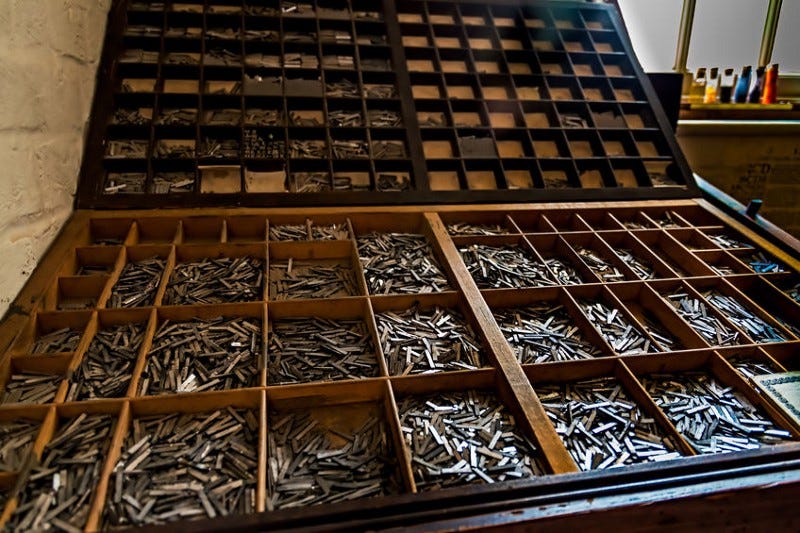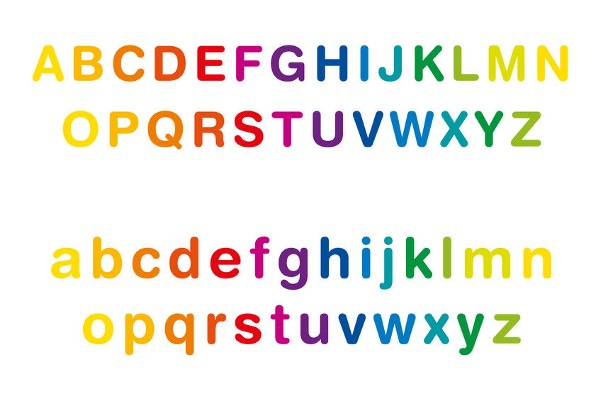Upper Case and Lower Case
Why We Write with Different Kinds of Letters
Why We Write with Different Kinds of Letters
When I was in junior high school (now known as “middle school”), my favorite courses were English (of course!) and my music classes. I played several instruments in the band and the orchestra and sang in the school choirs. But one of my other favorite classes was print shop. When I was in school, girls and boys took electives such as home economics and shop classes, and usually those classes were segregated by sex: girls took home ec classes and boys took shop classes.
But when I was in 7th grade, I had the opportunity to take print shop right along with the boys! That was quite unorthodox for that time period, but my print shop teacher didn’t make a distinction between boys and girls in his class.
In print shop, we were able to print everything the school needed: flyers, brochures, announcements, etc. It was a lot of fun and very heady to be given the responsibility of printing everything for the school office!
This was way before personal computers, and we actually used the old style printer cases with two sets of boxes that held every letter and punctuation mark. The capital letters were stored in the upper part of the case while the small letters were stored in the lower part of the case.
There were rows and rows of those two-part printing cases and we had to set every single letter of every sentence one-by-one into trays to make the document. The letters were set backward so that they would show up in print forward. It was a very detailed process. Then we very carefully and gingerly carried the heavy trays over to the manual printing press. Every once in a while, a student would drop their trays, or worse, accidentally knock over an entire case of hundreds of letters and punctuation marks. It would take several days to put everything back in the right places.
Because the capital letters were kept in the upper part of the type case, those letters came to also be known as “upper case.” The small letters were kept in the lower part of the type case, and so are still referred to as “lower case.”
The Transition from Books Handwritten by Scribes to Printed Books
Capital letters are officially known as majuscule, while small letters are officially known as minuscule (not “miniscule”). Back in the days when all documents were hand-written by scribes, all written letters in words were capital letters, and then later, all of the written letters in words were small letters, which were faster to write. By the early 1700s, capitalization rules were developed and standardized and most printing was completed with the moveable type method.
About Detroit Ink Publishing
In 2008, right in the middle of the Great Recession, I started my first company, Writing It Right For You (WIRFY), an…medium.com
There is a misconception in western history that the printing press was invented in Europe by Johannes Gutenberg. Actually, press printing was first invented in China with wood blocks around the 9th century, and then the process was refined in Korea over the next couple of centuries. Each page of a book was carved into a wooden block in reverse order, covered with ink, and then printed by pressing the block on paper. Because printed books in Asia during that time were intended only for nobility, the process was not widespread.
In about 1440, Johannes Gutenberg further improved on the press printing by inventing the metal moveable type where each letter and punctuation mark was arranged in a frame before being coated with ink and pressed onto the paper.
The moveable type process used the printing cases with the letters stored in the upper and lower cases and enabled the mass production of books available to more people in society than just the nobility and religious leaders. Even though the lower classes in Europe and North America were often illiterate until the rise of public education in the mid-1800s, easier and faster methods of book printing facilitated the number of books and other printed materials available at relatively low costs.
When I was an English teacher of all grades from elementary through university, I always taught my students to use the terms “upper case” and “lower case” instead of calling them capital and small letters. It was probably because of my fun and exciting experience in junior high print shop class.
If you would like to keep up with everything we’re doing at Detroit Ink Publishing (DIP) and our other group of companies Your Business Your Brand Creatively (YB2C), I invite you to sign up for our (almost) weekly email newsletter. We promise: No Spam! You can join the email list here.
My company offers editing, formatting, cover design, publishing, ghostwriting, and book and author marketing services in packages customized for each client.
If you would like to discuss a potential publishing project, you can schedule a 30-minute consultation at this link. After your initial consultation, our team will be prepared to develop a customized quote and project plan for you.




